Picture |
Object
name
#NORAD |
Description |
Mission
Date |
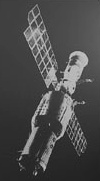
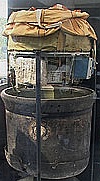
|
Salyut
5
Salyut-5
Salute 5
Almaz OPS 3
1976-057A
#08911 |
Salyut 5 was the second
successful Soviet Almaz space station launched from
the Baikonur Cosmodrome aboard a Proton 8K82K rocket.
Structurally it was similar to Salyut 3 with a mass
of 19 tons and two solar panels. It featured a detachable
recovery module for the return of research data and
materials which was ejected on February 26th
1977 and successfully recovered (picture shown left).
It was inhabited by two Soyuz crews and one Soyuz failed
to dock:
Soyuz 21 cosmonauts Boris Volynov and Vitali
Zholobov worked in the station from July 7th
to August 24th 1976.
Soyuz
23 failed to dock on October 15th
1976.
Soyuz 24 crew Viktor Gorbatko and Yuri Glazkov
worked in the station from February 8th
to 25th 1977.
Salyut 5
re-entered the atmosphere on August 8th
1977 after its fuel reserves were depleted. |
June
22nd 1976 |
 Enclosed
voice transmission from Boris Volynov onboard Salyut-5
was received on August 4th
1976 from 04:35 to 04:40 UTC on 143.625 MHz in FM modulation
by Sven Grahn. Enclosed
voice transmission from Boris Volynov onboard Salyut-5
was received on August 4th
1976 from 04:35 to 04:40 UTC on 143.625 MHz in FM modulation
by Sven Grahn.
|
 Enclosed
Almaz shortwave telemetry signal from Salyut-5 was received
on February 9th 1977 on 19.944
MHz by Sven Grahn. Enclosed
Almaz shortwave telemetry signal from Salyut-5 was received
on February 9th 1977 on 19.944
MHz by Sven Grahn.
|
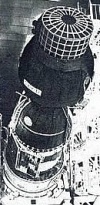
|
Soyuz
22
1976-093A
#09421
(crew: Bykovsky, Aksyonov) |
 Soyuz
22 was a Soviet manned mission with Cosmonauts Bykovsky
and Aksyonov aboard. Its purpose was the testing and
perfecting of scientific-technical methods and devices
for studying the geological characteristics of the Earth's
surface from outer space for economic purposes. It landed
150 km NW of Tselinograd and was recovered on September
23rd 1976 at 7:42 UTC. Soyuz
22 was a Soviet manned mission with Cosmonauts Bykovsky
and Aksyonov aboard. Its purpose was the testing and
perfecting of scientific-technical methods and devices
for studying the geological characteristics of the Earth's
surface from outer space for economic purposes. It landed
150 km NW of Tselinograd and was recovered on September
23rd 1976 at 7:42 UTC.
Enclosed voice signal was received on 142.4 MHz on September
19th 1976 by Sven Grahn.
|
Sept 15th
1976 |

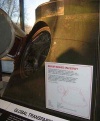
|
COSMOS
929
1977-066A
#10146 |
 Almaz
was the first test of the TKS manned shuttle. Maneuvered
extensively, the TKS-VA capsule returned to Earth August
16th 1977. The shuttle de-orbited
February 2nd 1978. Almaz
was the first test of the TKS manned shuttle. Maneuvered
extensively, the TKS-VA capsule returned to Earth August
16th 1977. The shuttle de-orbited
February 2nd 1978.
Enclosed
FSK-PDM signal was received on 19.954 MHz on September
20th 1977 by Sven Grahn.
|
July 17th 1977 |
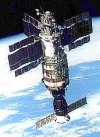
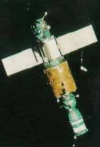
|
Salyut
6
Salyut-6
DOS 5
1977-097A
#10382 |
Salyut
6 was a second-generation (along with Salyut 7) Soviet
space station. With Salyut 6, the Soviet space station
program evolved from short-duration to long-duration
stays. It was launched unmanned and crews arrived later
in Soyuz spacecraft. It had two docking ports. This
permitted refueling and resupply by automated Progress
freighters derived from Soyuz. Progress docked automatically
at the aft port, and was then opened and unlocked by
cosmonauts on the station. Transfer of fuel to the station
took place automatically under supervision from the
ground. A second docking port also meant long-duration
resident crews could receive visitors. Visiting crews
often included cosmonaut-researchers from Soviet bloc
countries or countries sympathetic to the Soviet Union.
Vladimir Remek of Czechoslovakia, the first space traveler
not from the US or USSR, visited Salyut 6 in 1978. The
station received 16 cosmonaut crews, including six long-duration
crews. The longest stay time for a Salyut 6 crew was
185 days. The first long-duration crew stayed for 96
days, beating the 84-day world record for space endurance
established in 1974 by the last Skylab crew. The station
hosted cosmonauts from Hungary, Poland, Romania, Cuba,
Mongolia, Vietnam, and East Germany. Twelve Progress
freighters delivered more than 20 tons of equipment,
supplies and fuel. An experimental transport logistics
spacecraft called Cosmos 1267 docked with Salyut 6 in
1982. The transport logistics spacecraft was originally
designed for the Almaz program. Cosmos 1267 proved that
large modules could dock automatically with space stations,
a major step toward the multimodular Mir station and
the International Space Station.
Salyut 6 had six
resident crews. On 10 Dec. 1977 the first crew, Yuri
Romanenko and Georgi Grechko, arrived on Soyuz 26 and
remained aboard Salyut 6 for 96 days. On June 15th 1978,
Vladimir Kovalyonok and Alexander Ivanchenkov (Soyuz
29) arrived and remained on board for 140 days. Vladimir
Lyakhov and Valeri Ryumin (Soyuz 32) arrived on 25 Feb.
1979 and stayed 175 days. on 9 April 1980 Leonid Popov
and Valeri Ryumin (Soyuz 35) arrived for the longest
stay on Salyut 6, 185 days. A repair mission, consisting
of Leonid Kizim, Oleg Makarov, and Gennadiy Strekhalov
(Soyuz T3) worked on the space station for 12 days starting
on 27 Nov. 1980. On 12 March 1981 the last crew, Vladimir
Kovalyonok and Viktor Savinyikh, arrived and stayed
for 75 days. During this time there were also 10 visiting
missions, crews which came to bring supplies and make
shorter duration visits with the resident crews. |
Sept 29th 1977 |
 Enclosed
scrambled voice signal was received on 121.75 MHz on
July 9th 1978 at 16:04 UTC
by Sven Grahn. Enclosed
scrambled voice signal was received on 121.75 MHz on
July 9th 1978 at 16:04 UTC
by Sven Grahn.
|
 Enclosed
de-scrambled voice signal was received on 121.75 MHz
on July 9th 1978 at 16:04 UTC by Sven Grahn. Enclosed
de-scrambled voice signal was received on 121.75 MHz
on July 9th 1978 at 16:04 UTC by Sven Grahn.
|
 Electro-cardiogramme
transmission on voice channel, 121.75 MHz, May 11, 1979.
Recording kindly provided by Sven Grahn. Electro-cardiogramme
transmission on voice channel, 121.75 MHz, May 11, 1979.
Recording kindly provided by Sven Grahn.
|
 Enclosed
recording includes the voices of Popov and Ryumin, the
Soyuz-35 crew, most likely while they were onboard of
Salyut-6. Recording is part of the compilation "The
Conquest of Space" of the Astronautical Society
of Western Australia and kindly provided by Jos Heymann. Enclosed
recording includes the voices of Popov and Ryumin, the
Soyuz-35 crew, most likely while they were onboard of
Salyut-6. Recording is part of the compilation "The
Conquest of Space" of the Astronautical Society
of Western Australia and kindly provided by Jos Heymann.
|
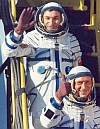

|
Soyuz-31
1978-081A
#11010
(crew: Waleri Fjodorowitsch Bykowski, Sigmund Jaehn) |
On August
26th 1978 the first German
Kosmonaut/Astronaut Sigmund Jähn (GDR) and commander
Cosmonaut Waleri Fjodorowitsch Bykowski.(USSR) started
their trip to the Salyut 6 Space Station on board of
Soyuz-31. Their mission was part of the Interkosmos
program and they conducted various experiments during
their 7 days and 20 hours stay aboard Salyut 6. They
landed with Soyuz-29 on September 3rd
1978.
 The
painting to the right is from Eberhard Marx. I got a
signed reprint from him in 2022. The
painting to the right is from Eberhard Marx. I got a
signed reprint from him in 2022.
I am searching for sound files. Please
send them to
 |
Aug 26th
1978 |

|
Soyuz-33
1979-029A
#11324
(crew: N. N. Rukavishnikov, G. I. Ivanov) |
Launched
to bring the "Saturn" crew N. N. Rukavishnikov
(USSR) and G. I. Ivanov (Bulgaria) to the Space Station
Salyut 6, Soyuz-33 failed to dock with Salyut 6 as there
was a malfunction of the main engine during its final
approach.
 The "Proton"
crew aboard Salyut 6 reported flames shooting sideways
from the main engine, toward the backup engine, at the
time of the shutdown. The docking was called off and
the "Saturn" crew made ready to return to
Earth. The "Proton"
crew aboard Salyut 6 reported flames shooting sideways
from the main engine, toward the backup engine, at the
time of the shutdown. The docking was called off and
the "Saturn" crew made ready to return to
Earth.
 Unfortunately
also the backup engine had difficulties and as a result,
Soyuz 33 made a steep ballistic reentry with acceleration
up to 10G (98 m/s²). Listen to the crew reading
the landing angles. Unfortunately
also the backup engine had difficulties and as a result,
Soyuz 33 made a steep ballistic reentry with acceleration
up to 10G (98 m/s²). Listen to the crew reading
the landing angles.
After the short mission of
2 days finally the "Saturn" crew arrived safely
on earth.
Both audio files were recorded on April
11th 1979 on 121.75 MHz by
Sven Grahn. |
Apr 10th 1979 |
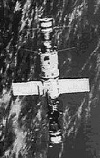
|
Soyuz
34
1979-0491A
#11387 |
 Soyuz
34 was launched unmanned by the USSR from the Baikonur
cosmodrome in order to return with the crew of Soyuz
32 after the failure of Soyuz 33 to dock with the Salyut
6 space station. It was recovered on August 19th
1979 at 12:30 UTC. Soyuz
34 was launched unmanned by the USSR from the Baikonur
cosmodrome in order to return with the crew of Soyuz
32 after the failure of Soyuz 33 to dock with the Salyut
6 space station. It was recovered on August 19th
1979 at 12:30 UTC.
Enclosed command-verification
signals were received on 925.24 MHz on June 7th
1979 by Sven Grahn.
|
June 6th 1979 |
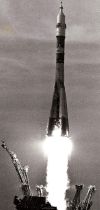
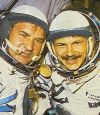
|
Soyuz
35
1980-027A
#11753 |
Soyuz 35 was a manned
Soviet mission launched from the Baikonur cosmodrome
carrying cosmonauts Leonid Popov and Valeri Ryumin to
the Salyut 6 space station. It also returned the crew
of Soyuz 36 to Earth on June 3rd
1980. |
April
9th 1980 |
 Enclosed
recording includes the voices of Popov and Ryumin, most
likely while they were onboard of Salyut-6. Recording
is part of the compilation "The Conquest of Space"
of the Astronautical Society of Western Australia and
kindly provided by Jos Heymann. Enclosed
recording includes the voices of Popov and Ryumin, most
likely while they were onboard of Salyut-6. Recording
is part of the compilation "The Conquest of Space"
of the Astronautical Society of Western Australia and
kindly provided by Jos Heymann.
|
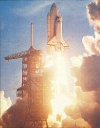
|
STS-1
Columbia
1981-034A
#12399
(crew: John W. Young, Robert L. Crippen) |
 German
report about the first launch of a space shuttle STS-1
(Space Transportation System) Columbia which was broadcasted
by Bayrischer Rundfunk. This was the first flight of
a re-usable manned spacecraft. The crew Commander John
W. Young and Pilot Robert L. Crippen returned safely
on April 14th 1981. Record
kindly provided by Maik Hermenau. German
report about the first launch of a space shuttle STS-1
(Space Transportation System) Columbia which was broadcasted
by Bayrischer Rundfunk. This was the first flight of
a re-usable manned spacecraft. The crew Commander John
W. Young and Pilot Robert L. Crippen returned safely
on April 14th 1981. Record
kindly provided by Maik Hermenau.
|
Apr
12th
1981 |
 Enclosed
recording documents the launch of the first flight of
a Space Shuttle, STS-1. Recording is part of the compilation
"The Conquest of Space" of the Astronautical
Society of Western Australia and kindly provided by
Jos Heymann. Enclosed
recording documents the launch of the first flight of
a Space Shuttle, STS-1. Recording is part of the compilation
"The Conquest of Space" of the Astronautical
Society of Western Australia and kindly provided by
Jos Heymann.
|


|
STS-2
Columbia
Shuttle-OFT2
OSTA1/STS-2
1981-111A
#12953
(crew: Joe Engle,
Richard Truly) |
The second
flight of the Space Shuttle Columbia (STS-2) carried
the first scientific payload OSTA-1 (Office of Space
and Terrestrial Application 1). |
Nov
12th
1981 |
 Enclosed
recording documents the launch of the second flight
of a Space Shuttle, STS-2. Recording is part of the
compilation "The Conquest of Space" of the
Astronautical Society of Western Australia and kindly
provided by Jos Heymann. Enclosed
recording documents the launch of the second flight
of a Space Shuttle, STS-2. Recording is part of the
compilation "The Conquest of Space" of the
Astronautical Society of Western Australia and kindly
provided by Jos Heymann.
|
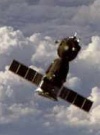
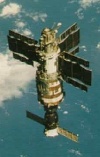
|
Soyuz
T-14
1985-081A
#16051
(crew: Vladimir Vasyutin, Georgiy Grechko, Aleksandr
Volkov) |
 Soyuz
T-14 was a manned Soviet mission launched from the Baikonur
cosmodrome with cosmonauts Vladimir Vasyutin, Georgiy
Grechko, and Aleksandr Volkov aboard. It docked with
the Salyut 7 space station but returned to Earth with
Viktor Savinykh, Volkov and Vasyutin on November 21st
1985 when Vasyutin became ill. Soyuz
T-14 was a manned Soviet mission launched from the Baikonur
cosmodrome with cosmonauts Vladimir Vasyutin, Georgiy
Grechko, and Aleksandr Volkov aboard. It docked with
the Salyut 7 space station but returned to Earth with
Viktor Savinykh, Volkov and Vasyutin on November 21st
1985 when Vasyutin became ill.
The scrambled voice
signal was received on 142.417 MHz on November 13th
1985 by Sven Grahn.
|
Sep 17th 1985 |

|
COSMOS
1686
1985-086A
#16095 |
 Cosmos
1686 was a modification of the cancelled TKS manned
ferry that docked with the Salyut 7 space station. All
landing systems were removed from the VA re-entry capsule
and replaced with military optical sensor experiments
(infrared telescope and Ozon spectrometer). It burned
up in the atmosphere and together with the Salyut 7
station over Argentina on February 7th
1991 04:00 UTC. It re-entered with the unused 3 m diameter
recoverable capsule of 2-3000 kg mass, solid rocket
motors, and cesium sensors. Cosmos
1686 was a modification of the cancelled TKS manned
ferry that docked with the Salyut 7 space station. All
landing systems were removed from the VA re-entry capsule
and replaced with military optical sensor experiments
(infrared telescope and Ozon spectrometer). It burned
up in the atmosphere and together with the Salyut 7
station over Argentina on February 7th
1991 04:00 UTC. It re-entered with the unused 3 m diameter
recoverable capsule of 2-3000 kg mass, solid rocket
motors, and cesium sensors.
The FSK-PDM signal was
received on 19.954 MHz on October 3rd
1985 by Sven Grahn.
|
Sep 27th 1985 |
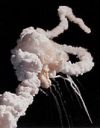

|
CHALNGR
STS 51L
Challanger
(crew: Francis
Scobee, Michael
Smith, Judith
Resnik, Ellison
Onizuka, Ronald
McNair, Gregory
Jarvis, Christa
McAuliffe) |
This mission,
one of the continuing STS series, carried a Tracking
and Data Relay Satellite (TDRS-B) to be launched from
the cargo bay, and the experiment Spartan Halley. The
spacecraft exploded during the launch phase at high
altitude over the Atlantic Ocean. All 7 crew members
were lost. Because the spacecraft did not reach orbit,
no International ID was assigned. |
Jan
28th
1986 |
 Enclosed
recording documents the failing launch and explosion
of Challanger. Recording is part of the compilation
"The Conquest of Space" of the Astronautical
Society of Western Australia and kindly provided by
Jos Heymann. Enclosed
recording documents the failing launch and explosion
of Challanger. Recording is part of the compilation
"The Conquest of Space" of the Astronautical
Society of Western Australia and kindly provided by
Jos Heymann.
|
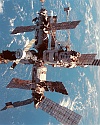
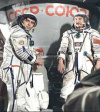
|
MIR
Space Station
1986-017A
#16609 |
Mir (english peace),
a Russian space station, was the world's first consistently
inhabited long-term research station in space. 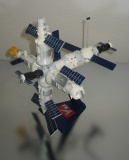 Constructed
from 1986 to 1996 using a modular design (core
module launched February 20th 1986) the station was
in operation for fifteen years before it was deliberately
de-orbited and re-entered into the atmosphere over the
South Pacific Ocean on March 23rd
2001. 10 years after its reentry I built a model of
MIR which is now in my bookshelf and a nice reminiscence
of the various contacts I had with people onboard MIR. Constructed
from 1986 to 1996 using a modular design (core
module launched February 20th 1986) the station was
in operation for fifteen years before it was deliberately
de-orbited and re-entered into the atmosphere over the
South Pacific Ocean on March 23rd
2001. 10 years after its reentry I built a model of
MIR which is now in my bookshelf and a nice reminiscence
of the various contacts I had with people onboard MIR. |
Feb
20th
1986 (core module) |
The first crew to visit
MIR were Leonid Kizim and Vladimir Soloviev. Their Soyuz
T-15 spacecraft was launched on March 13th
1986 and they docked to MIR on March 14th.
They stayed in space for 125 days and during that time
even travelled from MIR to Salyut 6 and back before
finally returning back to earth.
 The first
audio file was recorded by Sven Grahn on March 15th
1986 15:27 UTC on 121.75 MHz, apparently shortly after
they entered MIR. Many thanks to Sven Grahn. The first
audio file was recorded by Sven Grahn on March 15th
1986 15:27 UTC on 121.75 MHz, apparently shortly after
they entered MIR. Many thanks to Sven Grahn.
 The second
audio file was recorded the day after on March 16th
1986 14:14 UTC on 143.625 MHz also by Sven Grahn. The second
audio file was recorded the day after on March 16th
1986 14:14 UTC on 143.625 MHz also by Sven Grahn. |
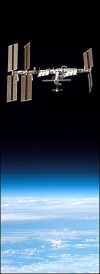

|
International
Space Station ISS
1998-067A
#25544 |
The first
crew of the ISS was the team of Commander William M.
Shepherd, Soyuz Pilot Yuri P. Gidzenko and Flight Engineer
Sergei Krikalev. They arrived with a Soyuz spacecraft
on Nov. 2nd 2000 and stayed
136 days.
 In the
sound file enclosed Bill Shepherd is thanking the ground
crews. Recorded shortly after arrival of the 1st
crew on Nov. 2nd 2000 at 12:27
UTC on 143.625 MHz by Sven Grahn. In the
sound file enclosed Bill Shepherd is thanking the ground
crews. Recorded shortly after arrival of the 1st
crew on Nov. 2nd 2000 at 12:27
UTC on 143.625 MHz by Sven Grahn. |
Nov
20th
1998
(Zarja module) |
 Enclosed
voice signal where the crew talks to TsUP was received
on 143.625 MHz on November 4th
2000 at 10:27 UTC by Sven Grahn. Enclosed
voice signal where the crew talks to TsUP was received
on 143.625 MHz on November 4th
2000 at 10:27 UTC by Sven Grahn.
|
 Mark Shuttleworth's
reporting was received on 143.625 MHz on April 28th
2002 at 08:25 UTC by Sven Grahn. Mark Shuttleworth's
reporting was received on 143.625 MHz on April 28th
2002 at 08:25 UTC by Sven Grahn.
|
 The crew
of Soyuz TMA-1 reported their arrival at ISS on 130.167
MHz on November 1st 2002 at
06:28 UTC. Received and kindly provided by Sven Grahn. The crew
of Soyuz TMA-1 reported their arrival at ISS on 130.167
MHz on November 1st 2002 at
06:28 UTC. Received and kindly provided by Sven Grahn.
|
 This relay
of the TsUP uplink to Soyuz TMA-2 was received on 130.167
MHz on April 28th 2003 at 05:45
UTC by Sven Grahn. This relay
of the TsUP uplink to Soyuz TMA-2 was received on 130.167
MHz on April 28th 2003 at 05:45
UTC by Sven Grahn.
|
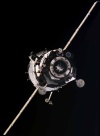
|
Soyuz
TMA-2
2003-016A
#27781
(crew: J. I. Malentschenko,
E. T. Lu) |
 Soyuz
TMA-2 is a Russian passenger transport craft that was
launched by a Soyuz-U rocket from Baikonur. It carried
cosmonaut Juri
Iwanowitsch Malentschenko (Russia) and astronaut
Edward Tsang Lu
(USA) for a six-month stay to the International Space
Station (ISS). It docked with the ISS on April 28th
2003 at about 07:00 UTC. TMA-2 returned with the old
crew of ISS back to Earth and they landed softly at
02:41 UTC on October 28th 2003
at the precisely planned location in Kazakhstan. Soyuz
TMA-2 is a Russian passenger transport craft that was
launched by a Soyuz-U rocket from Baikonur. It carried
cosmonaut Juri
Iwanowitsch Malentschenko (Russia) and astronaut
Edward Tsang Lu
(USA) for a six-month stay to the International Space
Station (ISS). It docked with the ISS on April 28th
2003 at about 07:00 UTC. TMA-2 returned with the old
crew of ISS back to Earth and they landed softly at
02:41 UTC on October 28th 2003
at the precisely planned location in Kazakhstan.
In enclosed recording Edward Lu talks in English on
121.75 MHz on April 27th 2003
at 07:05 UTC. Received by Sven Grahn.
|
Apr 26th
2003 |
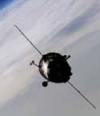
|
Soyuz
TMA-3
2003-047A
#28052
(crew: Alexander
Jurjewitsch Kaleri , Colin
Michael Foale, Pedro
Francisco Duque) |
 Soyuz
TMA-3 is a Russian passenger-transporting satellite
that was launched by a Soyuz-FG rocket from Baikonur.
It carried three astronauts (a Russian, an American
and a Spanish) to the International Space Station (ISS).
It docked automatically with the ZARYA module onOctober
20th 2003 and the crew moved
into the ISS. During his 10 day stay in the ISS the
Spanish astronaut conducted some microgravity life science
experiments. The other two crew members remained in
the ISS for a longer stay. Soyuz TMA-3 returned back
to Earth with another crew and landed softly at 11:15
UTC on April 30th 2004 in Kazakhstan. Soyuz
TMA-3 is a Russian passenger-transporting satellite
that was launched by a Soyuz-FG rocket from Baikonur.
It carried three astronauts (a Russian, an American
and a Spanish) to the International Space Station (ISS).
It docked automatically with the ZARYA module onOctober
20th 2003 and the crew moved
into the ISS. During his 10 day stay in the ISS the
Spanish astronaut conducted some microgravity life science
experiments. The other two crew members remained in
the ISS for a longer stay. Soyuz TMA-3 returned back
to Earth with another crew and landed softly at 11:15
UTC on April 30th 2004 in Kazakhstan.
In enclosed recording Michael Foale talks in English
on 121.75 MHz. Received on October 19th
2003 at 08:40 UTC by Sven Grahn.
|
Oct 18th
2003 |

|
Progress
M-02M
Progress 33P
2009-024A
#34905 |
 Progress
M-02M, a Russian unmanned resupply vessel for the International
Space Station, was launched on a Soyuz U rocket from
Baikonur. The spacecraft carried spare parts, life support
gear, and hardware. It also resupplied the station with
propellant, pure oxygen and air. The Progress vessel
had a total weight of 7119 kg and docked with the ISS
at the Earth-facing port of the Pirs module on May 12th
2009 at 19:24 UT. Prior to docking, the Progress was
used to perform tests of a new avionics system. During
docking Nils received enclosed signal from the TORU
(TeleOperatornuij Reschim Uprawlenja) system of the
progress space-ship on 121.746 MHz. Recording kindly
provided by Nils von Storch. Progress
M-02M, a Russian unmanned resupply vessel for the International
Space Station, was launched on a Soyuz U rocket from
Baikonur. The spacecraft carried spare parts, life support
gear, and hardware. It also resupplied the station with
propellant, pure oxygen and air. The Progress vessel
had a total weight of 7119 kg and docked with the ISS
at the Earth-facing port of the Pirs module on May 12th
2009 at 19:24 UT. Prior to docking, the Progress was
used to perform tests of a new avionics system. During
docking Nils received enclosed signal from the TORU
(TeleOperatornuij Reschim Uprawlenja) system of the
progress space-ship on 121.746 MHz. Recording kindly
provided by Nils von Storch.
|
May 7th
2009 |
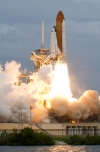
|
STS-135
Atlantis OV-104
2011-031A
#37736 |
STS-135 was the final
shutttle mission. It was launched in July 8th
2011 from Kennedy Space Center and docked to ISS on
July 10th 2011 at 15:07 UTC.
 STS-135
Atlantis's External Tank video downlink was received
over Europe by Nils von Storch 24 minutes after launch
on 2272.5 MHz FM. Normally an internal timer disables
the 10 Watts s-band video transmitter onboard the External
Tank (ET) about 15 Minutes after launch, to avoid interference
with S-Band communication systems in Europe. On this
final Space Shuttle mission however, engineers decided
to disable the timer in order to capture video from
the ETs perspective when it re-entries the earths atmosphere
about 60 minutes after launch. Unfortunately the signal
was at 4° elevation only before disappearing behind
the horizon again, which is the reason why the received
video is only so short. Equipment used to receive this
video was a 90cm mesh dish with 3,5 turn RHCP Helix
for 2250 MHz, EME103B S-Band LNA and a G1MFG S-Band
video receiver. Thanks to Nils for sharing this video
with us. The mission lasted 13 days ending with a landing
at Cape Canaveral on July 21st
2011 at 09:55 UTC. Please note that the .mp4-video is
almost 20 MByte large. STS-135
Atlantis's External Tank video downlink was received
over Europe by Nils von Storch 24 minutes after launch
on 2272.5 MHz FM. Normally an internal timer disables
the 10 Watts s-band video transmitter onboard the External
Tank (ET) about 15 Minutes after launch, to avoid interference
with S-Band communication systems in Europe. On this
final Space Shuttle mission however, engineers decided
to disable the timer in order to capture video from
the ETs perspective when it re-entries the earths atmosphere
about 60 minutes after launch. Unfortunately the signal
was at 4° elevation only before disappearing behind
the horizon again, which is the reason why the received
video is only so short. Equipment used to receive this
video was a 90cm mesh dish with 3,5 turn RHCP Helix
for 2250 MHz, EME103B S-Band LNA and a G1MFG S-Band
video receiver. Thanks to Nils for sharing this video
with us. The mission lasted 13 days ending with a landing
at Cape Canaveral on July 21st
2011 at 09:55 UTC. Please note that the .mp4-video is
almost 20 MByte large. |
July
8th
2011 |
 One
hour after separation, ISS and Atlantis STS135 were
still close to each other when they moved across Europe.
The reflections of the GRAVES radar at both objects
could be monitored on 143.050 MHz. Enclosed waterfall
was received on July 19th 2011 at 17:15 UTC by Phil
Williams. The lower trace is the reflection of Atlantis
then followed by ISS. Waterfall diagram kindly provide
by Phil Williams. One
hour after separation, ISS and Atlantis STS135 were
still close to each other when they moved across Europe.
The reflections of the GRAVES radar at both objects
could be monitored on 143.050 MHz. Enclosed waterfall
was received on July 19th 2011 at 17:15 UTC by Phil
Williams. The lower trace is the reflection of Atlantis
then followed by ISS. Waterfall diagram kindly provide
by Phil Williams.
|
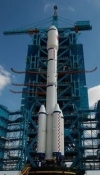
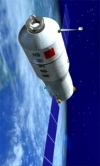
|
Tiangong-1
Tjangong-1
TG-1
#37820
(2011-053A) |
Tiangong-1
is the first Chinese space module. It is cylindrical
shaped with a diameter of 3.35m and a length of about
9m and weights 8500 kg. It features 2 deployable solar
panel arrays. It was launched on a modified CZ-2F rocket
called CZ-2F/G into an initial 335x353km orbit with
43° inclination will probably be raised at a later
point in time.
Reported active downlink frequencies
are 2208.800 MHz, 2224.120 MHz, 2232.250 MHz and 2250.750
MHz. |
Sept
29th 2011 |
 One
of the S-band downlinks of Tiangong-1 was received on
2232.244 MHz on October 3rd
2011 at 00:40 UTC by Loren Moline WA7SKT. You can see
the faint doppler curve in enclosed waterfall spectrum
plot which was kindly provided by Loren. One
of the S-band downlinks of Tiangong-1 was received on
2232.244 MHz on October 3rd
2011 at 00:40 UTC by Loren Moline WA7SKT. You can see
the faint doppler curve in enclosed waterfall spectrum
plot which was kindly provided by Loren.
|
  On
May 2nd 2013 at 08:35 UTC Paul
Marsh received Tiangong-1 on 2232.250 MHz and on 2250.750
MHz. Waterfall and spectrum plot kindly provided by
www.uhf-satcom.com. On
May 2nd 2013 at 08:35 UTC Paul
Marsh received Tiangong-1 on 2232.250 MHz and on 2250.750
MHz. Waterfall and spectrum plot kindly provided by
www.uhf-satcom.com.
|
   Enclosed
audio recordings, the first two of the PSK TT&C
signal on 2232 MHz and the third of the main carrier
at 2251 MHz were received on May 7th
2013 at 07:00 GMT. Recorded and kindly provided by Paul
Marsh M0YET. Enclosed
audio recordings, the first two of the PSK TT&C
signal on 2232 MHz and the third of the main carrier
at 2251 MHz were received on May 7th
2013 at 07:00 GMT. Recorded and kindly provided by Paul
Marsh M0YET.
|
 The
S-Band downlink of Tiangong-1 was received and enclosed
FFT plot was generated in April 2014 by Milen Rangelov. The
S-Band downlink of Tiangong-1 was received and enclosed
FFT plot was generated in April 2014 by Milen Rangelov.
|
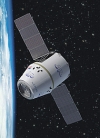
|
Dragon
C2+
Dragon C2/C3
#38348
(2012-027A) |
The Dragon
capsule was developed by Space-X and is the first private
built capsule which supplied goods (544kg) to the ISS:
It was launched on a falcon 9 rocket on May 22nd
2012 from Cape Canaveral and docked to the ISS on May
25th 2012. During approach
to the ISS the communication with the ISS took place
on 400.5 MHz using 338 kHz PSK modulation with a data
rate of 153.6 kbps. The reported transmit power was
5W resulting in 1.5 W EIRP. Other reported downlink
frequencies were in S-band:
2205.5 MHz (narrow band
telemetry),
2216.0 MHz (TLM via directional S-band
antenna and 20 Watts),
2265.0 MHz (wide band telemetry). |
May
22nd 2012 |
 Enclosed
signal was received during orbit #29 on May 24th
2012 at 8:23 UTC using a handheld arrow antenna and
a Yaesu VX-8R receiver by the Salmi family in Chelmsford,
MA. Bryce KB1LQC, Brent KB1LQD and John KB1MGI. The
recorded the signal on 400.5 MHz in AM using the recording
function of their cell phone. Recording kindly provided
by Bryce Salmi KB1QC. Enclosed
signal was received during orbit #29 on May 24th
2012 at 8:23 UTC using a handheld arrow antenna and
a Yaesu VX-8R receiver by the Salmi family in Chelmsford,
MA. Bryce KB1LQC, Brent KB1LQD and John KB1MGI. The
recorded the signal on 400.5 MHz in AM using the recording
function of their cell phone. Recording kindly provided
by Bryce Salmi KB1QC.
|
 Enclosed
spectrum plot and waterfall diagram was recorded on
May 27th 2012 around 01:44
UTC on 400.5 MHz by Darko 9A3LI. Raw data recordings
are available on request. Kindly provided by Darko 9A3LI. Enclosed
spectrum plot and waterfall diagram was recorded on
May 27th 2012 around 01:44
UTC on 400.5 MHz by Darko 9A3LI. Raw data recordings
are available on request. Kindly provided by Darko 9A3LI.
|
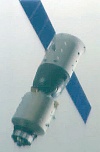

|
Shenzou
9
SZ 9
#38461
(2012-032A) |
The SZ
(Shenzou) is the first manned spacecraft
of the Peoples Republic of China. The 7800kg spacecraft
owns much of its basic design to the russian Soyuz capsule,
which has a very similar genaral layout. Like the Soyuz,
it consists of an orbital module, a return module and
an engineering module. Shenzou-9 docked automatically
to the Chinese space laboratory Tiangong-1 and all three
Taikonaunts Mr. Jing Haipeng, Mr. Liu Wang und Mrs.
Liu Yang entered the space laboratory.
Downlink frequencies have been reported
to be 259.2-260.2 MHz, 294.2-299.3 MHz and 2224.065
MHz (S-Band). |
June 16th
2012 |


|
TMA08-M
34S
#39125
(2013-013A) |
 On March
28th 2013 a new crew consisting
of Flight Engineer Christopher Cassidy, Commander
Pavel Vinograd and Flight Engineer Aleksandr Misurkin
(from left to right) was launched on a Soyuz rocket
from Baykonur to ISS. This is the first time a new 6
hour fast rendezvous flight profile is used. Enclosed
signal was received and recorded on March 28th
2013 at 23:45 UTC using a AOR AR-3000 receiver on 121.750
MHz in FM by Marco Bauer. On March
28th 2013 a new crew consisting
of Flight Engineer Christopher Cassidy, Commander
Pavel Vinograd and Flight Engineer Aleksandr Misurkin
(from left to right) was launched on a Soyuz rocket
from Baykonur to ISS. This is the first time a new 6
hour fast rendezvous flight profile is used. Enclosed
signal was received and recorded on March 28th
2013 at 23:45 UTC using a AOR AR-3000 receiver on 121.750
MHz in FM by Marco Bauer.
|
March 28th
2013 |
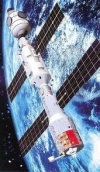

|
Shenzou
10
SZ 10
#39179
(2013-029A) |
Shenzou 10 was
the 5th
and up to this point longest manned mission of
the Peoples Republic of China. It was launched on June
11th 2013 on a CZ-2F/G rocket.
The mission lasted 15 days. On June 13th
2013 at 07:11 UTC Shenzou-10 docked automatically
to the Chinese space laboratory Tiangong-1 and one hour
later all three Taikonaunts commander Nie Haisheng,
mission engineer Zhang Yiaoguang und mission engineer
Mrs. Wang Yaping entered the space laboratory. This
was the last planned visit to the space module Tjangong-1. |
June
11th 2013 |
  The
S-band TT&C signal from Shenzhou-10 was received
by Paul Marsh on June 16th
2013 at 12:11 UTC at 2208.757 MHz and at 15:24 UTC at
2208.707 MHz. Enclosed spectrum plots were kindly provided
by Paul Marsh M0YET. The
S-band TT&C signal from Shenzhou-10 was received
by Paul Marsh on June 16th
2013 at 12:11 UTC at 2208.757 MHz and at 15:24 UTC at
2208.707 MHz. Enclosed spectrum plots were kindly provided
by Paul Marsh M0YET.
|


|
TMA13-M
ISS-AF39S
#39775
(2014-031A) |
 On May
28th 2014 a new crew consisting
of German Flight Engineer Alexander
Gerst, Commander Maxim
Wiktorowitsch Surajew and Flight Engineer
Gregory
Reid Wiseman (from left to right) was launched
on a Soyuz rocket from Baykonur to ISS. Enclosed signal
was received and recorded on May 29th
2014 between 00:34 and 00:39 UTC using a AOR AR-3000
receiver on 121.750 MHz in FM by Marco Bauer. He used
a handheld 5el Yagi antenna. About 70 mintes later TMA13-M
docked to ISS. Long pauses have been removed to reduce
the filesize. Recording kindly provided by Marco Bauer. On May
28th 2014 a new crew consisting
of German Flight Engineer Alexander
Gerst, Commander Maxim
Wiktorowitsch Surajew and Flight Engineer
Gregory
Reid Wiseman (from left to right) was launched
on a Soyuz rocket from Baykonur to ISS. Enclosed signal
was received and recorded on May 29th
2014 between 00:34 and 00:39 UTC using a AOR AR-3000
receiver on 121.750 MHz in FM by Marco Bauer. He used
a handheld 5el Yagi antenna. About 70 mintes later TMA13-M
docked to ISS. Long pauses have been removed to reduce
the filesize. Recording kindly provided by Marco Bauer.
|
May 29th
2014 |
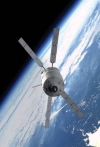
|
ATV-5
Georges
Lemaître
#40103
(2014-044A) |
On
Saturday February 14th 2015
ESA’s fifth and last Automated Transfer Vehicle (ATV),
Georges Lemaître, undocked from the International
Space Station at 13:40 GMT. Less than 30 hours later
the spacecraft burnt up harmlessly in a controlled reentry
over the Pacific Ocean, marking the end of the program.
All 5 ATVs were built by EADS Astrium Space Transportation
in Bremen/Germany and delivered in total more than 31
tons of supplies over the course of the five missions.
They boosted the Station to raise its orbit numerous
times and similarly moved it out of the way of space
debris. The vehicles demonstrated European mastery of
automated docking, a technology that is vital for further
space exploration.
 The
image to the right “Final Goodbye” was taken by amateur
photographer Alex Spiller in Saxony, Germany, shortly
after ATV undocked from ISS. Travelling from west to
east at around 28 800 km/h, ATV-5 is visible as a faint
stripe to the right of the brighter stripe – the International
Space Station ISS. This was one of the last pictures
of ATV-5 before its reentry. The
image to the right “Final Goodbye” was taken by amateur
photographer Alex Spiller in Saxony, Germany, shortly
after ATV undocked from ISS. Travelling from west to
east at around 28 800 km/h, ATV-5 is visible as a faint
stripe to the right of the brighter stripe – the International
Space Station ISS. This was one of the last pictures
of ATV-5 before its reentry.
Image kindly provided
by Alex Spiller. |
July 29th
2014 |

|
International
Space Station ISS
1998-067A
#25544 |
 On Monday
December 21st 2015 Astronauts
Scott Kelly and Timothy Kopra jointly conducted an EVA
to free a stuck CETA (Crew & Equipment Translation
Aid) cart. During this EVA Alex Spiller was able to
receive their intercom signal based on the SSER (Space-to-Space
EMU Radio). He received and recorded the signal on 414.2
MHz on December 21st 2015 at
15:08 - 15:18 UTC. Recording kindly provided by Alex
Spiller. On Monday
December 21st 2015 Astronauts
Scott Kelly and Timothy Kopra jointly conducted an EVA
to free a stuck CETA (Crew & Equipment Translation
Aid) cart. During this EVA Alex Spiller was able to
receive their intercom signal based on the SSER (Space-to-Space
EMU Radio). He received and recorded the signal on 414.2
MHz on December 21st 2015 at
15:08 - 15:18 UTC. Recording kindly provided by Alex
Spiller.
|
Dec 21st
2015 |
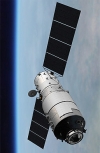
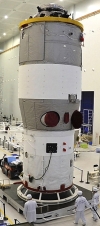
|
Tiangong-2
TG 2
2016-057A
#41765 |
Tiangong 2 (TG 2)
is the second Chinese experimental space station. The
back-up built for Tiangong 1, has been modified with
improved living conditions to verify key technologies,
such as on-orbit propellant resupply using the new Tianzhou
logistics vehicle. The station is also equipped with
a new robotic arm. Tiangong-2
carries 14 types of experiments focusing on cutting-edge
technologies such as space materials science and space
life science. Tiangong
2 was launched on a CZ-2F/T rocket in September 2016
into an initial 197 km × 373 km, 42.8° orbit,
which it later raised to a 369 km × 378 km, 42.8°
orbit. Only
one crewed ship, Shenzhou 12, was planned
to visit
the station for a 30 day mission, which was successfully
conducted. |
Sep
15th 2016 |
  The
S-band downlink signal from Tiangong-2 on 2232.232 MHz
was received by DD1US on February 12th
2018 at 17:05 UTC. Demodulated in FM. The
S-band downlink signal from Tiangong-2 on 2232.232 MHz
was received by DD1US on February 12th
2018 at 17:05 UTC. Demodulated in FM.
|
  The
S-band downlink signal from Tiangong-2 on 2250.710 MHz
was received by DD1US on February 12th
2018 at 18:40 UTC. Demodulated in USB. The
S-band downlink signal from Tiangong-2 on 2250.710 MHz
was received by DD1US on February 12th
2018 at 18:40 UTC. Demodulated in USB.
|
Picture |
Object
name
#NORAD |
Description |
Mission
Date |